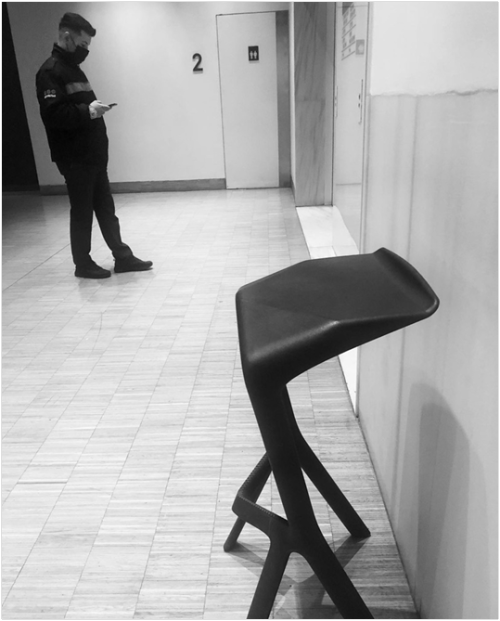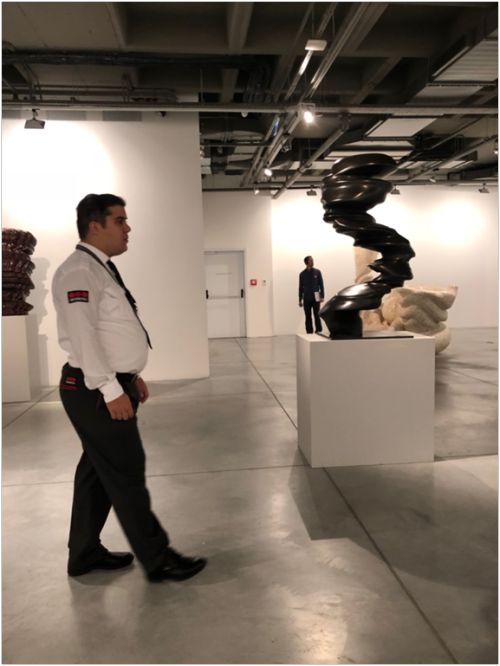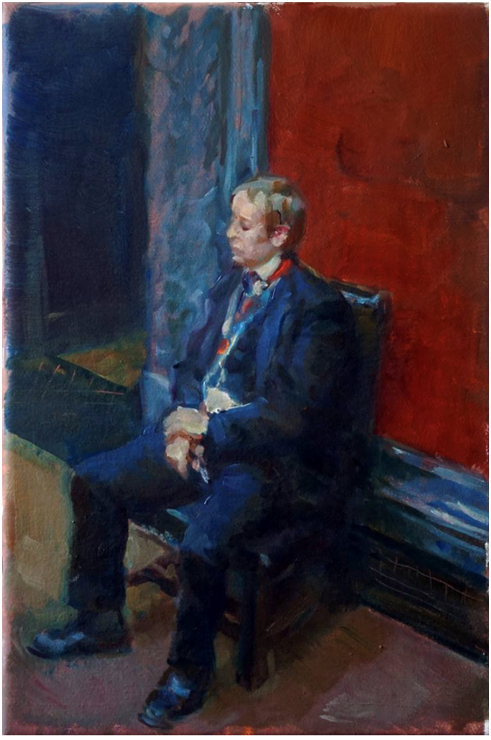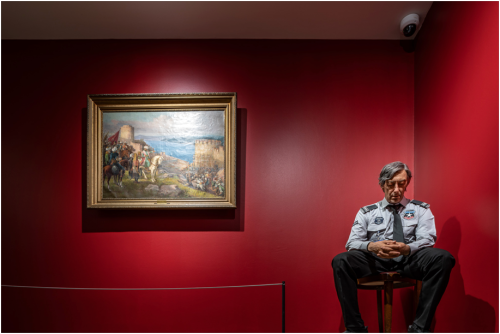
Since September I have been spending most of my time working in the ANAMED study room at my desk near the window with a top-down view of Istiklal and the chaotic background noise of the street. Although I have been a local of Istanbul since 2017, being a fellow at ANAMED sometimes brings an old feeling back from the times when I was at foreign places for research; the senses of foreignness and loneliness tangled with the thrill of being at an unexplored place. Art museums have always been one of the first places I visit in cities that are new to me. That was always a nourishing activity for me, and so I continue to do so in Istanbul, especially when I feel distressed.
When I was in London for my post-doc, the Tate Modern became a shelter for me. The city is full of art museums and galleries, and I have visited many of them (Tate Britain, White Chapel, Saatchi, Victoria and Albert, White Cube, Dulwich Picture Gallery, etc.), but the Tate Modern was the only one I visited weekly. It was not only the exhibitions but the building itself that I found soothing. I remember myself going there every week, sitting on a comfortable leather coach in a dark room where they were playing Derek Jarman’s Blue. Until it was removed from the exhibition, I watched and listened to Blue once a week, beginning from different sections of the work. It was not only because I adore Jarman and his work, but also because I found peace in that dark room with its blue screen and the calming voices of the narrators.
This year while at ANAMED I got back to my old habit, and whenever I feel exhausted with work I throw myself into SALT, the Pera Museum, Meşher, Galeri Nev, or Galerist, which are within walking distance from ANAMED. But perhaps SALT Galata just across from ANAMED is my new shelter for times of exhaustion. Although I am not a foreigner to this city anymore, this habit of relaxing at art galleries continues and gives me more comfort than anything. My interest in art museums is not only about the exhibitions, but the environment made of the space, sounds, and people; but I particularly find it interesting to think about museum guards. Museum guards are responsible for protecting the exhibits from any sort of violation and warning people against any actions potentially causing damage to art pieces. It is kind of strange that it is required to protect art from its viewers, but also certainly not unnecessary. There are many cases of museum vandalism in history, and most have found place in the press, also. The first case that comes to my mind is the guy who smashed Ai Weiwei’s vase, valued 1M USD in 2014 at the Miami Art Museum. Ironically, that was a reanimation of Ai Weiwei’s provocative art video showing one of his clients smashing an urn of the artist. Art vandalism is nothing new though: Picasso’s master piece, Guernica, was marred in 1974 at the Museum of Modern Art in New York by a man entering the place in daytime and spray painting in red the words “Kill Lies All”. It is still a common phenomenon, as we see in a recent case where exhibits were splashed by an oily liquid at German museums. In one of the latest cases of museum vandalism, the museum guard himself become the violator, drawing eyes with a ballpoint pen on the abstract human figures of an avant-garde painting by Anna Leporskaya at Boris Yeltsin Presidential Center. It was his first day on the job, and it was reported that although his motives are unknown his action might have arisen from boredom and a lapse in sanity. Boredom is the major feeling associated with the museum guards. Although art vandalism is always potentially possible, the daily scenes of museum guards are mostly monotonous (Fig. 1).They mostly spend the long work days in dim light galleries where they may only perch on intentionally uncomfortable seats (Fig. 2).

Fig. 2. Seat for the museum guard at SALT Galata (Photo by the author).
I am not convinced with the idea that they could only be bored looking at these exhibits every day. Do they think about the art pieces? Do they enjoy being exposed to them all day long? Is it exhausting to get exposed to art on a daily basis, all the pieces, as well as the sounds and people? Do they talk about the exhibits when they go home (Figs. 3–4)?

Fig. 3. Museum guard at Istanbul Modern (Photo by the author)

Fig. 4. Museum guards chatting at the Lincoln Gallery of the Smithsonian American Art Museum, Washington (photo by the author).
Floating my ideas on museum guards by my friend Pelin Uran, who is an art curator, she made me aware that museum guards have long been very popular in the contemporary art scene as a subject of art. Arnold Mesches’s lithograph depicting a museum guard dated to 1967 (Fig. 5), Dan Shiloh’s “A woman museum guard in Israel” of 2018 (Fig. 6), Banksy’s Museum Guard at Martineau Road, London (Fig. 7), and Michail Schnittmann’s Museum Guard painting (Fig. 8) are only a few of the art pieces that capture the spirit of museum guards.

Fig. 5 Arnold Mesches, Museum Guard, 1967.

Fig. 6. Dan Shiloh, A woman museum guard in Israel, 2018.

Fig. 7. Banksy, Museum Guard at Martineau Road, London.

Fig. 8. Michail Schnittmann’s Museum Guard painting.

Fig. 9 Halil Altındere, a silicone sculpture of Sleeping Museum Guard in Yapı Kredi Bank’s Collection (Photo Credit: Murat Germen)
Another one by Halil Altındere, a silicone sculpture of a Sleeping Museum Guard in Yapı Kredi Bank’s Collection, demonstrates a museum guard taking a nap on his chair (Fig. 9). All these depictions of museum guards reflect a solid expression of boredom. These works also give the impression that they hardly appreciate the art that they are responsible to protect.
However, this is not the case in reality, and more comprehensive works reveal the interaction and engagement of museum guards with exhibits. These works seek beyond what we see, or even take one step further and make them part of the artwork.Tino Sehgal’s “Constructed Situation” is an exquisite example that took place at the Stedelijk Museum, Amsterdam in 2012; the museum guards have become part of the art performance. Alec Soth’s 2014 work at the Minneapolis Institute of Art focusing on the “Secret Lives of Museum Guards” included photographs of guards with their favourite works of art and interviews about their jobs. He captures the guards in front of their favourite work and also interviews them about their experience as museum guards. His work opens up a unique course into the worlds of museum guards and is full of unexpected and interesting stories. Perhaps the most exciting work on museum guards is the recent one entitled “Guarding the Art” that opened in March 2022 at Baltimore Museum of Art. In this exhibition, museum guards are assigned as guest curators offering different perspectives from within the museum hierarchy. As they are the ones who spend the most time with the art, their perspectives have great potential for learning more about how exhibits are perceived by viewers. Perhaps after reading this piece some of you may get more interested with other features of art museums as well as exhibits. Museums are not only places full of objects, but rather lively spaces, if we may slide out of the tyranny of materialism and enjoy each visit as a one-time experience.

